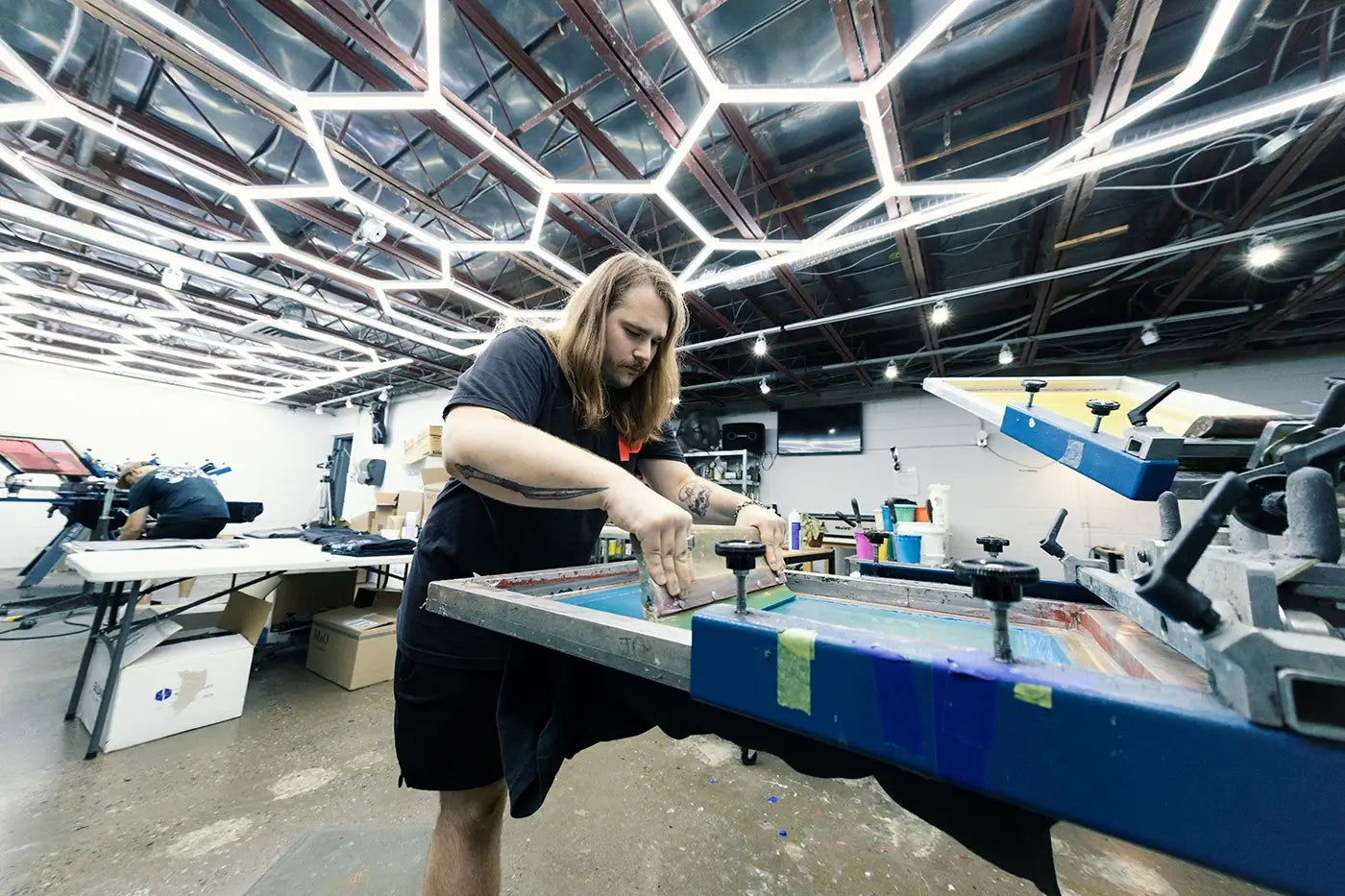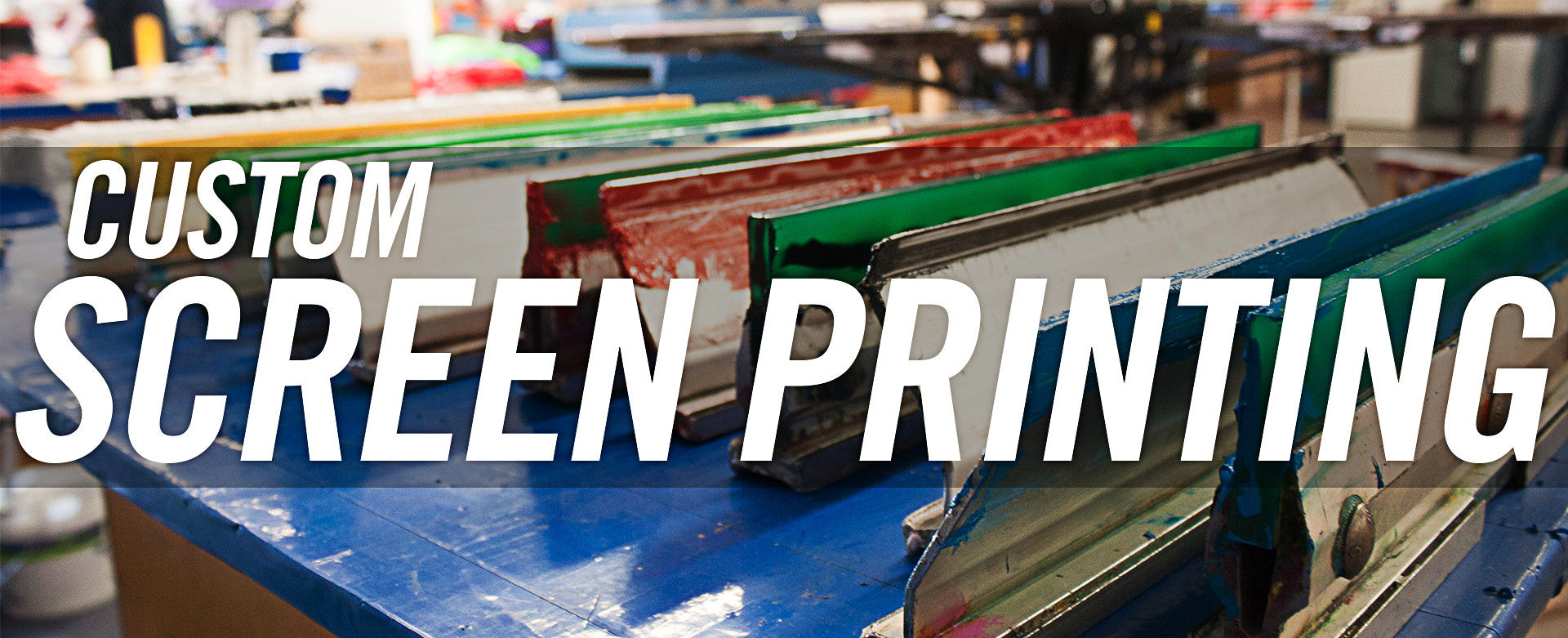Creative T-Shirt Printing Ideas for Small Brands
Creative T-Shirt Printing Ideas for Small Brands
Blog Article
Screen Printing Uncovered: Every Little Thing You Need to Know Concerning T-Shirt and Garment Printing Methods
If you have actually ever before wondered how those lively layouts wind up on your favored t-shirts, you're in the right place. Display printing is a fascinating technique that incorporates art with strategy, supplying endless possibilities for creativity. Recognizing the principles, from tools to ink selections, can substantially affect your results. All set to discover the crucial components that make screen publishing an art form? Allow's reveal the information that can raise your jobs.
The Basics of Screen Printing: How It Functions
When you plunge right into screen printing, you'll discover it's both an art and a scientific research. At its core, display printing involves developing a stencil, or display, that enables ink to go through just in specific locations (screen printing kit). You start by selecting your design and preparing your display with a light-sensitive emulsion. When you expose this emulsion to light, it sets, leaving your style as an adverse area.
Following, you'll mix your inks and prepare your printing surface. Placement the screen over the textile, after that use a squeegee to press ink through the display onto the garment. This procedure requires precision, as you want clear, lively prints. After printing, you'll cure the ink with warm, guaranteeing it follows the material and lasts via washes. Each action is vital, and understanding them will boost your display printing skills, transforming straightforward garments into one-of-a-kind, expressive pieces.
Kinds Of Display Printing Techniques
When you realize the basics of screen printing, it's time to explore the different strategies that can elevate your styles. One prominent technique is traditional screen printing, where ink is pushed through a stenciled screen. This strategy is fantastic for bold, lively shades. Then there's water-based ink printing, which offers a softer feeling and is green, yet it calls for a various approach to healing.
If you're going for fine details, consider discharge printing. This strategy gets rid of color from the material, leaving a soft, vintage appearance. Another option is plastisol printing, known for its longevity and dazzling colors, making it a favored for lots of brands. Finally, trying out halftone printing to produce gradient results and complex designs. Each strategy has its special charm, so do not hesitate to try them out to discover what suits your design best!
Essential Devices for Screen Printing
To accomplish stunning lead to display printing, having the best tools is fundamental. Initially, you'll need a strong display printing structure, which holds the mesh that moves your style onto the garment. Next off, spend in top notch squeegees; these are vital for using ink evenly across the screen. You'll additionally call for a good exposure system to develop your displays, as well as a washout booth for cleansing them after usage. A trustworthy heat source, like a conveyor dryer or warm press, is important for healing your prints to guarantee longevity. Don't fail to remember a correct workspace, geared up with tables and storage for your materials. Safety equipment, such as handwear covers and masks, will certainly maintain you secure from chemicals and inks. With the right devices, you'll be well on your means to producing professional-quality prints.
Selecting the Right Inks and Materials
When picking inks and products for display printing, you require to think about the kind of ink that functions best for your project. Consider fabric compatibility to guarantee your designs look terrific and last lengthy. Additionally, check out green ink options to make your printing procedure more lasting.
Sorts Of Display Inks
Picking the right display ink is essential for achieving lively, durable prints that satisfy your project's requirements. There are a number of kinds of display inks to check out. Specialty inks, such as metal or glow-in-the-dark, can include one-of-a-kind effects to your styles.

Material Compatibility Factors To Consider
Recognizing textile compatibility is essential for attaining high-quality screen prints, especially since different products react distinctly to different inks. When choosing inks, think about the textile kind-- cotton, polyester, or blends. For cotton, water-based inks work well, offering gentleness and breathability. Polyester, on the other hand, usually needs plastisol inks for far better bond and vivid shades. You might need to utilize a combination of both kinds if you're publishing on blends. Constantly examine your inks on example fabric to assure they stick appropriately and preserve shade stability. Additionally, remember that material recommended you read weight and texture can impact the last outcome, so choosing the right ink and material combo is vital for your job's success.
Eco-Friendly Ink Options
Environment-friendly inks are becoming a prominent choice for display printers that want to minimize their environmental influence while preserving top quality. When choosing inks, take into consideration water-based inks, which are less damaging and easier to cleanse up compared to typical solvents.
Additionally, try to find inks made from renewable resources, such as soy or vegetable-based options. By picking the ideal inks and materials, click this link you'll not just develop sensational styles yet also add to a more lasting printing procedure. Make the button, and your prints will show your commitment to the atmosphere!
Preparing Your Layout for Display Printing

File Format Needs
To ensure your design looks vivid and sharp on material, you'll require to pay very close attention to submit style requirements for screen printing. Start with vector files like AI or EPS, as they can be scaled without losing high quality. If you utilize raster pictures, select high-resolution files, such as TIFF or PNG, ideally at 300 DPI. Avoid using JPEGs, as they can lose clarity when resized. Likewise, make sure your layout has a transparent history to stop unwanted white sides on your prints. Finally, maintain color modes in mind; CMYK is common for display printing, so convert your RGB develops as necessary. By adhering to these standards, you'll establish your art work up for an effective print.
Shade Splitting Up Strategies
Shade splitting up is a vital step in preparing your layout for screen printing, and mastering it can substantially improve your print high quality. You'll require to break your layout into specific colors, as each shade requires a different display during printing. This accuracy not only ensures accurate color representation but additionally improves the over at this website printing procedure.
Resolution and Size
Accomplishing the very best cause display printing starts with ensuring your design has the ideal resolution and size. Ideally, your art work should be at the very least 300 DPI (dots per inch) for sharp, clear prints. If you use reduced resolution, your last product may look pixelated and unprofessional.
When it comes to size, take into consideration the dimensions of your print area. Layout your art work to match the final print dimension, preferably creating it in the actual measurements you'll be publishing. In this manner, you'll prevent any unforeseen scaling concerns.
Always examine your design in both vector and raster styles. Vector graphics can be scaled without losing quality, making them ideal for display printing. Preparing correctly will ensure your design looks outstanding on every garment!
Step-by-Step Display Printing Refine
Display printing is a vibrant process that permits you to develop vibrant layouts on various surfaces. To obtain started, you'll need a display, solution, and your selected ink.
After rinsing the unexposed solution, your screen is prepared. Establish it up on your printing surface and align your garment underneath it. Pour ink onto the display and utilize a squeegee to push the ink via the stencil onto the textile. Raise the screen meticulously and let the print dry. Finally, cure the ink utilizing warmth to assure sturdiness. That's it! You have actually effectively display printed your design.
Tips for Effective Screen Printing Projects
While you're diving into your display printing projects, keep in mind that prep work is vital to success. Start by collecting all your products-- inks, displays, mops, and garments. A tidy office assists stop unwanted mistakes, so clean prior to you begin.
Next, verify your art work is high-resolution and appropriately sized for your garment. Evaluate your screen for appropriate direct exposure and clean it thoroughly to stay clear of smudges. When blending your inks, comply with the manufacturer's guidelines to attain the right consistency.
During printing, apply also stress with your squeegee for regular results. Do not hurry; take your time to verify each print satisfies your criteria. After printing, let your garments dry entirely prior to managing or packaging them.
Last but not least, always maintain an example of your work for future recommendation. By doing this, you can assess your development and boost your methods with time. Happy printing!

Regularly Asked Inquiries
How Long Does It Take to Establish a Screen Printing Job?
Setting up a screen printing task normally takes around 30 mins to an hour. You'll prepare the screens, mix inks, and adjust journalism. The moment varies based on intricacy and experience, so remain organized!
Can I Print on Various Material Enters Using the Very Same Strategy?
Yes, you can print on different textile types using the very same method, but you'll need to readjust your inks and settings. Some textiles take in ink differently, so experimenting warranties the very best results for each material.
What Are Typical Errors to Prevent in Screen Printing?
When display printing, prevent usual errors like utilizing the wrong ink, neglecting correct exposure times, or missing pre-press checks. Always examine your configuration and maintain tidy displays to guarantee top quality results each time.
Just How Can I Correctly Tidy and Maintain My Display Printing Equipment?
To appropriately clean and preserve your display printing devices, you need to routinely clean screens with ideal solvents, check mops for wear, and guarantee all devices are stored completely dry and dust-free. Consistency enhances and stops costly repair work efficiency.
Is Display Printing Ecologically Friendly Compared to Other Techniques?
Display printing can be more ecologically pleasant than various other methods, particularly if you use eco-conscious products and water-based inks. By selecting lasting supplies and methods, you lower waste and minimize your influence on the earth.
Screen Printing Uncovered: Whatever You Required to Know Concerning T-Shirt and Garment Printing Techniques
At its core, screen printing includes developing a pattern, or screen, that permits ink to pass via only in particular locations. Placement the display over the fabric, then utilize a squeegee to press ink through the display onto the garment. One prominent method is standard display printing, where ink is pressed via a stenciled display.When picking inks and products for display printing, you require to take right into account the kind of ink that functions ideal for your task.
Report this page